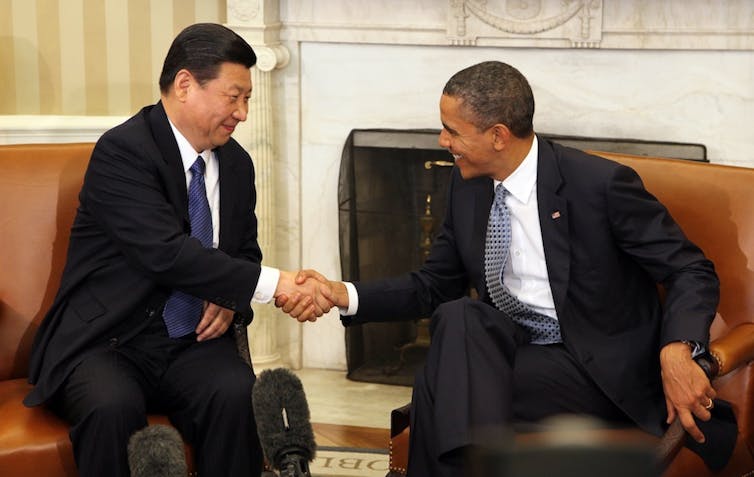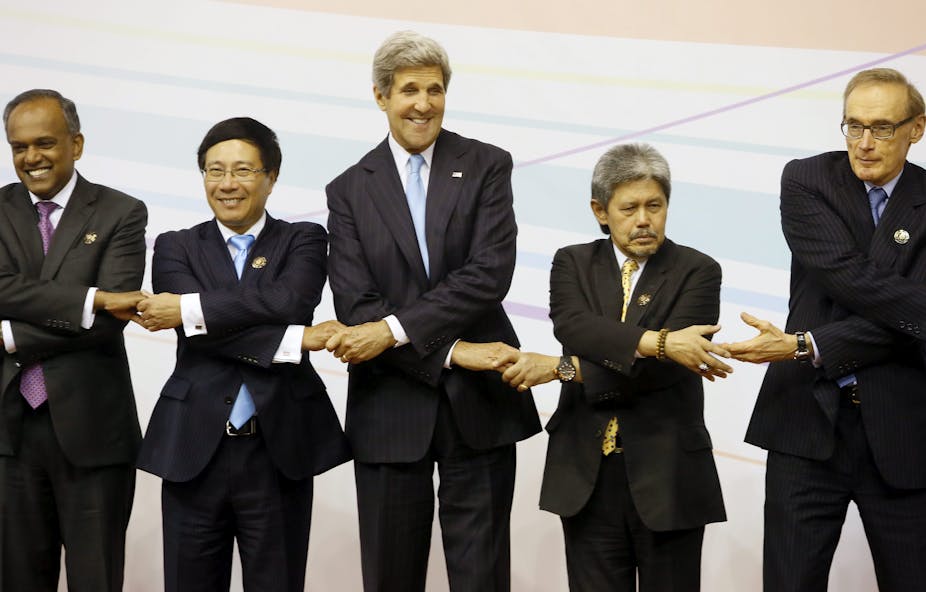Although foreign policy was a low priority in its election campaign, the new government is entering a 15-month period when Australia is uniquely placed to set international agendas. Australia will take over the G20 chair, culminating in the November 2014 G20 summit in Brisbane – the most important international meeting ever on Australian soil. Next month at the APEC Summit in Indonesia and the East Asia Summit in Brunei Darussalam, Australia has the opportunity to discuss priorities with world leaders before setting a G20 agenda in December.
The government has signalled that it will continue the Russian G20 presidency’s focus on “jobs and growth”. While this is an appropriate overarching objective, Mike Callaghan has argued in a recent report from the Lowy Institute that Australia needs to identify specific objectives:
“One key priority should be trade. The G20 should be worried about the future of the international global trading system after the failure of the Doha round and the trend towards mega-regional, and discriminatory, trade deals.”
Trade in a rule-based environment
The evidence of a positive connection between trade and growth is strong. Openness to the global economy was a crucial ingredient for the rapid growth enjoyed by Japan and then the Asian Tigers in the second half of the twentieth century. In Australia the dismantling of trade barriers since the 1980s underpinned the last two decades’ stellar growth performance. The BRICS and other emerging economies are all integrated into the global economy. This is not to say that opening-up is sufficient or that there are no losers who may deserve compensatory transfers, but openness to trade is a necessary condition for prosperity.
The World Trade Organisation matters because its rules provide the legal framework for international trade and it has a dispute settlement mechanism. The advantage of this system is reflected in the continuing increase in WTO membership, currently 159 members and 24 applicants, which include all major economies; pariah states like North Korea and Turkmenistan head the outsiders.
After its establishment in 1995, the WTO progressed important agreements such as the 1996 Information Technology Agreement that freed trade in IT goods and paved the way for efficient production of smart phones and other products manufactured in complex global value chains. However, the WTO lost its way in 2001 by announcing a new round of multilateral negotiations, the Doha Development Round, which became mired in failure to reach consensus among 159 members.
The rise of bilateralism and the ensuing noodle bowl
Meanwhile, bilateral agreements have flourished, especially in Asia. Many focus on a few key constraints that the negotiators want to reduce. Hence, the network of agreements has become increasingly heterogeneous. Trade policymakers are seeking a way to untangle the noodle bowl of overlapping agreements.
Australia joined the trend, signing agreements since 2003 with Singapore, Thailand, the USA, Chile and ASEAN. It is important to recognise the diversity. The easily negotiated agreement between low-tariff Singapore and Australia covered minor issues of mutual interest. The agreement with the USA involved detailed bargaining about market access where trade is not free, with a focus on US suppliers of patented pharmaceuticals and Australian farmers’ access to heavily protected US agricultural markets. The ASEAN-Australia agreement is a classic free trade agreement, with zero tariffs on trade among the partners and almost 100% coverage.

TPP and RCEP as alternative approaches
To simplify the noodle bowl, two processes have competing visions: the ASEAN-led Regional Comprehensive Economic Partnership (RCEP) and the US-led Trans-Pacific Partnership (TPP). The RCEP generalises the ASEAN free trade area and agreements such as that between Australia and ASEAN to all trade among the ASEAN+6 countries (i.e. ASEAN, China, Japan, Korea, Australia, New Zealand and India). Proponents of the TPP argue that this is old-style tariff-focused integration, whereas the TPP is a new-age agreement going beyond tariffs. Like the Australia-US agreement, TPP requires lengthy secret negotiations, currently entering their 20th round. The USA offers privileged access to its huge market in return for agreements in areas such as intellectual property or foreign investment where other countries are leery.
The RCEP model is essentially the open regionalism promoted by Australia within APEC in the 1990s. Countries with low trade barriers open up their markets to preferential free trade as a stepping-stone to deeper integration. There may be some trade diversion (i.e. promoting internal trade at the expense of more efficient external suppliers), but this misallocation is likely to be minor when trade barriers are low. Non-discriminatory trade would be better, but if this cannot be agreed within Doha then RCEP may be a good second-best outcome.
TPP is a different matter. It follows the North American Free Trade Agreement (NAFTA) pattern of the USA trading market access for specific concessions. Mexican textile manufacturers, for example, have access to the protected US market as long as they use US yarn. In the TPP, the United States is making a similar offer to Vietnam, which may benefit Vietnam on balance, but will hurt Chinese yarn suppliers. For Australia the negotiating ground is again the extent to which domestic policies should be modified to benefit US interests in return for better access to the US market for key farm products.
Many commentators view the RCEP versus TPP contest in terms of international relations: RCEP excludes the East Pacific (read USA) while TPP excludes those unwilling to bargain on US terms (read China). From an economic perspective, however the comparison is apples and oranges. RCEP envisages a WTO-consistent (Article XXIV) free trade area, continuing the Asian trade liberalisation of the last three decades that underlies the flourishing of efficient regional value chains. The TPP is a return to the pre-WTO concept of trading market access concessions, where bargaining is inevitably unequal.
Australia’s Challenge
Australia must choose whether to cement bilateral relations with the USA via the TPP or to continue the regional integration begun with the Australia-ASEAN agreement. The bigger picture involves our vision of the world trade system, and that is where the G20 agenda matters. The principles of the WTO need to be restated, Doha ditched as a false trail, and minimum standards on intellectual property, trade-related investment measures, rules of origin, etc brought within the ambit of world trade law. In the long run, this vision is far more important than making sacrifices to US tech or pharmaceutical interests in return for more sugar exports.

